Pulsed ultraviolet light can be a low-risk method to improve food safety.
Problem
How can poultry producers reduce the risk of disease-causing bacteria?
- Nine percent of all foodborne illness in the U.S. is associated with eggs. Every year in the U.S., an average of 287 eggs are consumed per person, and more than 14.1 billion eggs are incubated to produce chicks for the egg and poultry meat industries.
Findings
Researchers explored the use of pulsed ultraviolet (UV) light to kill pathogens on eggshells. The surfaces of shell eggs were inoculated with nonpathogenic bacteria strains used for research and were treated with pulsed ultraviolet light derived from a xenon flashlamp. Eggs were exposed on a modified egg-carrying conveyor that provided complete rotation of eggs under the flashlamp.
- The team learned that pulsed UV light, delivered at high intensity, resulted in faster and greater microbial reduction on the eggshell surface than what is reported for conventional UV light treatment.
- They also found no negative effects on hatching eggs and the embryos and chicks derived from treated eggs, even at 10 times the UV-light intensity.
Impact
Without water or chemical sanitizers, this scalable technology can achieve equal or greater microbial reductions than some currently available technologies. This decontamination method can be used with both table and hatching eggs to improve food safety.
Research Credit
Team
- Josh Cassar, Lindsey Bright, Paul Patterson, Ed Mills, Ali Demirci
Participating Departments
Other Funding
- Penn State College of Agricultural Sciences Undergraduate Research Program
Federal and State Appropriations
- USDA NIFA Hatch Project PEN04696, Accession #1018953
- Hatch Multistate Projects PEN04714 and PEN04740, Accession #1023215 and #1020402
Emerging Discoveries
Published Research
The efficacy of pulsed ultraviolet light processing for table and hatching eggs
-
Cassar, J. R., Bright, L. M., Patterson, P. H., Mills, E. W., & Demirci, A. (2021). The efficacy of pulsed ultraviolet light processing for table and hatching eggs. Poultry science, 100(3), [100923]. https://doi.org/10.1016/j.psj.2020.12.021
Office for Research and Graduate Education
Address
217 Agricultural Administration BuildingUniversity Park, PA 16802-2600
- Email agresearch@psu.edu
- Office 814-865-3136
Office for Research and Graduate Education
Address
217 Agricultural Administration BuildingUniversity Park, PA 16802-2600
- Email agresearch@psu.edu
- Office 814-865-3136



